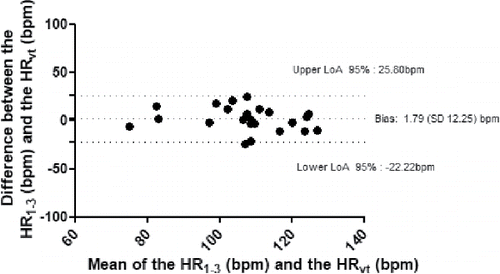Dear Editor,
We would like to thank Malaguti et al. for their interest in our study Citation(1). The aim of the study was to develop a predictive equation based on the six-minute stepper test (6MST) to determine the appropriate intensity at which to begin pulmonary rehabilitation, particularly for use in centers with limited access to comprehensive cardiopulmonary exercise testing (CPET). We chose to use the 6MST because it is reliable (Citation2–5), easy to set up (it does not require a 30-meter corridor, unlike the 6-minute walk test), is not a maximal test (unlike the incremental shuttle test), and is therefore feasible in an outpatient setting after cardiac evaluation.
We agree that the use of heart rate (HR) to determine the target exercise training intensity for patients with COPD is debatable. Nonetheless, individualized training at the HR corresponding to the ventilatory threshold (Vt) has been shown to be effective in patients with obstructive disease Citation(6). Since the Vt does not occur at the same percentage of VO2 peak in every patient, it can be used to determine specific metabolic stress levels for each individual. Moreover, as it corresponds to a breakdown in ventilation transition, good compliance with the training is more likely. We could have chosen to use perceived dyspnea, however, similarly to HR, the use of perceived dyspnea alone to determine exercise intensity in patients with COPD remains controversial Citation(7). As suggested, dyspnea could be added to HR to refine the predictive equations from the multivariate regression, however we chose not to do this because of the small size of our study sample Citation(8). A multicenter study that includes dyspnea in the equation is underway (NCT02842463).
We agree with Malaguti et al. that the ventilatory threshold is not always detected in patients with COPD. Moreover, the capacity of human observers to determine this parameter is debatable Citation(9). We acknowledged this in our discussion and suggested the relationship between the 6MST and CPET in the early stages of COPD (i.e., patients who achieve the ventilatory threshold and do not need a comprehensive CPET) should be investigated further.
We disagree with the comment made by Malaguti et al. regarding the low level of functional impairment in our patients. Contrary to their statement, the patients in our study performed a mean of 186.8 (SD 59.4) steps, which is half the value reported by Borel et al. in their original study Citation(2), suggesting a high level of impairment.
Linear regression was used to derive a predictive equation to set rehabilitation intensity, according to the main aim of the paper. As we suggested to use the HR from the first three minutes of the 6MST, the Bland–Altman analysis confirms our results with a mean bias of 1.79 (SD 12.25) bpm and 95% limits of agreement ranging from −22.22 to 25.80 bpm ().
Figure 1. Bland and Altman analysis. HRvt: heart rate at the ventilatory threshold; HR1–3: mean HR during the first three minutes of the 6MST; LoA: limit of agreement; bpm: beat per minute.

Finally, we wish to highlight that whether the initial intensity of pulmonary rehabilitation is based on comprehensive CPET (using either HR at the Vt, a percentage of the maximal O2 consumption or a percentage of the maximal workload achieved) or a field test (such as the six-minute stepper test or the incremental shuttle walk test), it simply provides an indication of the appropriate starting intensity. This initial intensity is not definitive and should be adapted to the patient's tolerance (dyspnea or leg fatigue) (Citation1, Citation2), with the aim to progressively increase the duration and intensity of the training (Citation2, Citation3). Therefore, the choice of test should not only be based on current literature, but also the constraints and preferences of each rehabilitation center (six-minute walk test, 6MST, incremental shuttle test etc.). The intensity should then be adapted to the individual patient and his or her response to pulmonary rehabilitation.
Disclosure of potential conflicts of interest
No potential conflicts of interest were disclosed.
References
- Bonnevie T, Gravier FE, Leboullenger M, Medrinal C, Viacroze C, Cuvelier A, Muir JF, Tardif C, Debeaumont D. Six-minute stepper test to set pulmonary rehabilitation intensity in patients with COPD—A retrospective study. COPD. 2017;14(3):293–297. doi:10.1080/15412555.2017.1303040. PMID: 28388274.
- Borel B, Fabre C, Saison S, Bart F, Grosbois JM. An original field evaluation test for chronic obstructive pulmonary disease population: the six-minute stepper test. Clin Rehabil. 2010;24(1):82–93. doi:10.1177/0269215509343848. PMID: 20053721.
- Coquart JB, Lemaitre F, Castres I, Saison S, Bart F, Grosbois J. Reproducibility and sensitivity of the 6-minute stepper test in patients with COPD. COPD. 2015;12(5):533–538. doi:10.3109/15412555.2014.974733. PMID: 25526322.
- Grosbois J, Riquier C, Chehere B, Coquart J, Béhal H, Bart F, Wallaert B, Chenivesse C. Six-minute stepper test: a valid clinical exercise tolerance test for COPD patients. Int J Chron Obstruct Pulmon Dis. 2016;11:657–663. PMID: 27099483.
- Pichon R, Couturaud F, Mialon P, Le Ber-Moy C, Peran L, Lochon C, Nowak E, Beaumont M. Responsiveness and minimally important difference of the 6-minute stepper test in patients with chronic obstructive pulmonary disease. Respiration. 2016;91(5):367–373. doi:10.1159/000446517. PMID: 27216848.
- Vallet G, Ahmaidi S, Serres I, Fabre C, Bourgouin D, Desplan J, Varray A, Préfaut C. Comparison of two training programmes in chronic airway limitation patients: standardized versus individualized protocols. Eur Respir J. 1997;10(1):114–22. doi:10.1183/09031936.97.10010114. PMID: 9032502.
- Horowitz MB, Littenberg B, Mahler DA. Dyspnea ratings for prescribing exercise intensity in patients with COPD. Chest. 1996;109(5):1169–75. doi:10.1378/chest.109.5.1169. PMID: 8625662.
- Van Voorhis CRW, Morgan BL. Understanding power and rules of thumb for determining sample sizes. Tutor Quant Methods Psychol. 2007;3(2):43–50. doi:10.20982/tqmp.03.2.p043.
- Dube BP, Mesbahi M, Beaucage F, Pepin V. Reliability of the determination of the ventilatory threshold in patients with COPD. Med Sci Sports Exerc. 2016;48(2):210–8. doi:10.1249/MSS.0000000000000770. PMID: 26355247
